
Phallaceae is a family of fungi, commonly known as stinkhorns, within the order Phallales. Stinkhorns have a worldwide distribution, but are especially prevalent in tropical regions. They are known for their foul-smelling, sticky spore masses, or gleba, borne on the end of a stalk called the receptaculum. The characteristic fruiting-body structure, a single, unbranched receptaculum with an externally attached gleba on the upper part, distinguishes the Phallaceae from other families in the Phallales. The spore mass typically smells of carrion or dung, and attracts flies, beetles and other insects to help disperse the spores. Although there is great diversity in body structure shape among the various genera, all species in the Phallaceae begin their development as oval or round structures known as "eggs". The appearance of Phallaceae is often sudden, as gleba can erupt from the underground egg and burst open within an hour. According to a 2008 estimate, the family contains 21 genera and 77 species.
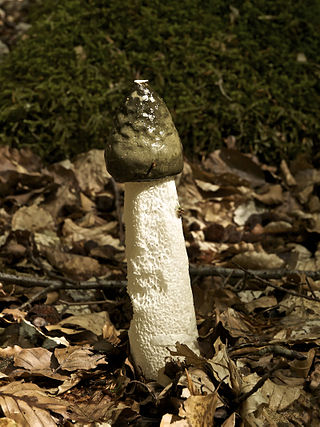
Phallus impudicus, known colloquially as the common stinkhorn, is a widespread fungus in the Phallaceae (stinkhorn) family. It is recognizable for its foul odor and its phallic shape when mature, the latter feature giving rise to several names in 17th-century England. It is a common mushroom in Europe and North America, where it occurs in habitats rich in wood debris such as forests and mulched gardens. It appears from summer to late autumn. The fruiting structure is tall and white with a slimy, dark olive colored conical head. Known as the gleba, this material contains the spores, and is transported by insects which are attracted by the odor—described as resembling carrion. Despite its foul smell, it is not usually poisonous and immature mushrooms are consumed in parts of France, Germany and the Czech Republic.

Phallus ravenelii, commonly known as Ravenel's stinkhorn, is a fungus in the Phallaceae (stinkhorn) family. It is found in eastern North America. Its mushrooms commonly grow in large clusters and are noted for their foul odor and phallic shape when mature. It is saprobic, and as such it is encountered in a wide variety of habitats rich in wood debris, from forests to mulched gardens or sawdust piles in urban areas. It appears from August to October. The fruit body emerges from a pink or lavender-colored egg to form a tall, cylindrical, hollow and spongy white stalk with a bell-shaped cap. The remains of the egg persist as a white to pink or lilac volva at the base of the stalk. The cap is covered in a foul-smelling olive-green spore slime, which attracts insects that help to spread the spores. Sometimes, the cap has a "veil" attached—a thin membrane that hangs underneath. The lack of a roughly ridged and pitted cap differentiates it from the closely related Phallus impudicus. The fungus is named after Henry William Ravenel, a botanist who first discovered it in 1846, though it remained undescribed until 1873. It is considered to be an edible mushroom while in its egg form.

Phallus duplicatus is a species of fungus in the stinkhorn family. The bell-shaped to oval cap is green-brown and the cylindrical stalk is white. When mature, the cap becomes sticky with a slimy green coating, which attracts flies that disperse its spores, and a distinct, "netted" universal veil. It often grows in public lawns, and can also be found in meadows. The fungus is edible when still in the "egg" stage, before the fruit body has expanded.

Phallus rubicundus is a species of fungus in the stinkhorn family. First described in 1811, it has a wide distribution in tropical regions. It has the typical stinkhorn structure consisting of a spongy stalk up to 15 cm (5.9 in) tall arising from a gelatinous "egg" up to 3 cm (1.2 in) in diameter. Atop the stalk is a pitted, conical cap that has a foul-smelling, gelatinous, green spore mass spread over it.
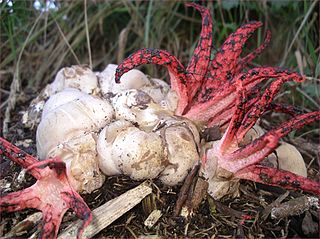
Clathrus archeri, commonly known as octopus stinkhorn or devil's fingers, is a fungus which has a global distribution. This species was first described in 1980 in a collection from Tasmania. The young fungus erupts from a suberumpent egg by forming into four to seven elongated slender arms initially erect and attached at the top. The arms then unfold to reveal a pinkish-red interior covered with a dark-olive spore-containing gleba. In maturity it smells like putrid flesh.

Clathrus ruber is a species of fungus in the family Phallaceae, and the type species of the genus Clathrus. It is commonly known as the latticed stinkhorn, the basket stinkhorn, or the red cage, alluding to the striking fruit bodies that are shaped somewhat like a round or oval hollow sphere with interlaced or latticed branches. The species was illustrated in the scientific literature during the 16th century, but was not officially described until 1729.
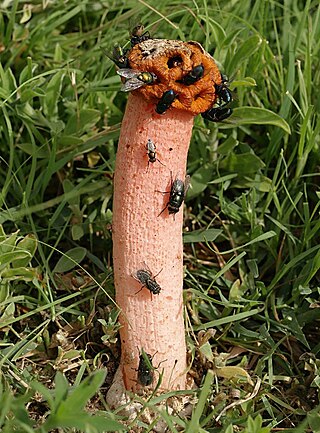
Lysurus periphragmoides, commonly known as the stalked lattice stinkhorn or chambered stinkhorn, is a species of fungus in the stinkhorn family. It was originally described as Simblum periphragmoides in 1831, and has been known as many different names before being transferred to Lysurus in 1980. The saprobic fungus has a pantropical distribution, and has been found in Africa, Asia, Australasia, and the Americas, where it grows on fertile ground and on mulch. The fruit body, which can extend up to 15 cm (5.9 in) tall, consists of a reddish latticed head placed on top of a long stalk. A dark olive-green spore mass, the gleba, fills the interior of the lattice and extends outwards between the arms. Like other members of the family Phallaceae, the gleba has a fetid odor that attracts flies and other insects to help disperse its spores. The immature "egg" form of the fungus is considered edible.

Pseudocolus fusiformis is a stinkhorn mushroom in the Phallaceae, a family well known for a remarkable range of fruit body types. It is commonly known as the stinky squid, because of its fetid odor, and its three or four upright "arms" which are connected at the top. The malodorous smell comes from the dark greenish slimy gleba covering the inside faces of the arms, and attracts insects that help to disperse the spores.

Clathrus columnatus, commonly known as the column stinkhorn, is a saprobic species of basidiomycete fungus in the family Phallaceae. Similar to other stinkhorn fungi, the fruiting body, known as the receptaculum, starts out as a subterranean "egg" form. As the fungus develops, the receptaculum expands and erupts out of the protective volva, ultimately developing into mature structures characterized by two to five long vertical orange or red spongy columns, joined at the apex. The fully grown receptaculum reaches heights of 8 cm tall. The inside surfaces of the columns are covered with a fetid olive-brown spore-containing slime, which attracts flies and other insects that help disseminate the spores.

Mutinus elegans, commonly known as the elegant stinkhorn, the dog stinkhorn, the headless stinkhorn, or the devil's dipstick, is a species of fungus in the Phallaceae (stinkhorn) family. The fruit body begins its development in an "egg" form, resembling somewhat a puffball partially submerged in the ground. As the fungus matures, a slender orange to pink colored stalk emerges that tapers evenly to a pointed tip. The stalk is covered with a foul-smelling slimy green spore mass on the upper third of its length. Flies and other insects feed upon the slime which contains the spores, assisting in their dispersal.

Amanita aestivalis, commonly known as the white American star-footed amanita, is a species of fungus in the mushroom family Amanitaceae. The cap of the white fruit body is 5 to 8.5 centimetres in diameter. It sits atop a stem that is 8.5 to 16 cm long. The entire fruit body will slowly stain a reddish-brown color in response to bruising. A. aestivalis may be a synonym for A. brunnescens, and may be confused with several other white-bodied amanitas. The fungus is distributed in eastern North America.

Amanita exitialis, also known as the Guangzhou destroying angel, is a mushroom of the large genus Amanita. It is distributed in eastern Asia, and probably also in India where it has been misidentified as A. verna. Deadly poisonous, it is a member of section Phalloideae and related to the death cap A. phalloides. The fruit bodies (mushrooms) are white, small to medium-sized with caps up to 7 cm (2.8 in) in diameter, a somewhat friable ring and a firm volva. Unlike most agaric mushrooms which typically have four-spored basidia, the basidia of A. exitialis are almost entirely two-spored. Eight people were fatally poisoned in China after consuming the mushroom in 2000, and another 20 have been fatally poisoned since that incident. Molecular analysis shows that the species has a close phylogenetic relationship with three other toxic white Amanitas: A. subjunquillea var. alba, A. virosa and A. bisporigera.

Amanita nothofagi is a species of fungus in the family Amanitaceae. Endemic to New Zealand, the species was first described by mycologist Greta Stevenson in 1962. The fruit bodies have dark brown caps that are up to 13 cm (5.1 in) in diameter and covered with patches of soft greyish-brown scales or warts. The gills underneath the cap are crowded together, free from attachment to the stem, and white, becoming tinged with yellow in age. The stem of the mushroom is 4–14 cm (1.6–5.5 in) long by 0.5–2.5 cm (0.2–1.0 in) thick, and has a ring. The spore print is white, and individual spores are spherical to ellipsoid, measuring 7.5–9 by 7.5–9 micrometres. The mushroom may be confused with another New Zealand species, A. australis, but can be distinguished by certain characteristics. Amanita nothofagi is a mycorrhizal species, and grows in association with native New Zealand trees such as Southern Beech.

Clathrus transvaalensis is a species of fungus in the stinkhorn family. It is found in South Africa. It was described as new to science in 1990 by mycologists Albert Eicker and Derek Reid. The fruit body forms a hollow, pale yellow to pinkish lattice structure.
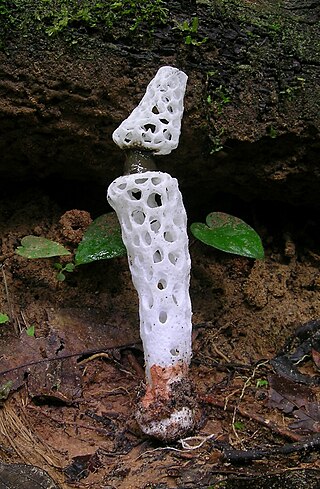
Staheliomyces is a fungal genus in the stinkhorn family. The genus was considered monotypic for over 100 years, containing the single neotropical species Staheliomyces cinctus, until a 2022 study revealed four additional, cryptic species. Members are colloquially known as the strangled stinkhorns. The genus is found in Central America and northern South America. The fruit body of the fungus is a hollow, whitish, cylindric stalk up to 16 cm (6.3 in) tall, with conspicuous pits and holes. Near the top of the stalk is a pinched-off zone covered with unpleasant-smelling slimy spore mass called gleba. The gleba attracts stingless bees that help disseminate the spores.

Colus hirudinosus is a species of stinkhorn fungus (Gasteromycete) found in Asia, Australia, northern Africa, and southern Europe. The fruit body has a short, thick stalk that divides into several spongy, wrinkled, stalk-like, orange to red columns that are united at the top, thus forming a lattice. The spores are found within the gleba—a dark, olive-brown slime that coats the inside of the columns. Spores are spread by insects that are attracted by the fetid smell of the gleba, eat the spores, and pass them on to germinate elsewhere.
Amanita zambiana, commonly known as the Zambian slender Caesar, is a basidiomycete fungus in the genus Amanita. An edible mushroom, it is found in Africa, where it is commonly sold in markets.
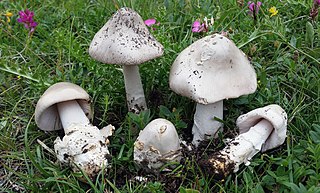
Amanita nivalis, the snow ringless amanita or mountain grisette, is a species of basidomycote fungus in the genus Amanita.

Colus pusillus is a species of fungus in the family Phallaceae. It is found in Australia. It is sometimes known as the craypot stinkhorn or basket stinkhorn, a reference to the unique appearance of the fruiting bodies which consist of vivid red, wrinkled arms that branch and connect to form a cage-like structure reminiscent to that of the related species Clathrus ruber. This fungus is saprobic and makes frequent appearances on garden mulch as a result.



















